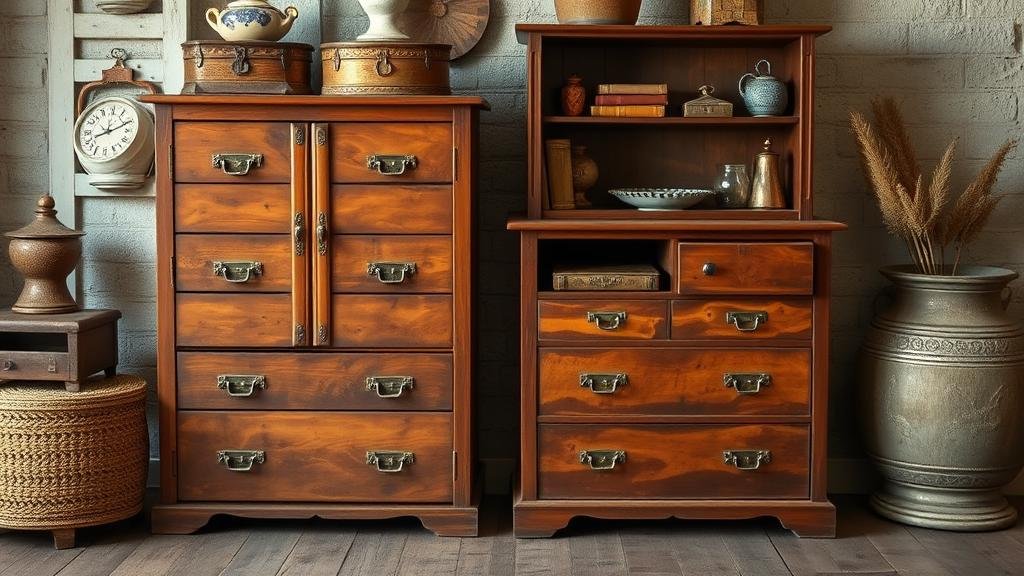Unearthing Treasure Hidden in Antique Storage Chests and Cabinets
Unearthing Treasure Hidden in Antique Storage Chests and Cabinets
Antique storage chests and cabinets serve not only as functional pieces of furniture but also as enigmatic vessels of history. Often filled with forgotten items, these artifacts can provide valuable insights into past lifestyles and societal values. This article will explore the various types of antique storage chests and cabinets, the treasures they may hold, methods for uncovering these treasures, and their significance in contemporary culture.
The Allure of Antique Storage Furniture
Historic storage chests and cabinets, ranging from simple wooden boxes to intricately carved cabinets, are often valued for their craftsmanship and aesthetic appeal. Each piece has a story, reflecting its era of creation, societal context, and the lives of previous owners. For example, a 17th-century coffer might reveal clues about trade routes and economic conditions of the time, while a Victorian-era cabinet could showcase the complexity of social hierarchy and domestic life.
Types of Antique Storage Furniture
Recognizing the different types of antique storage furniture is crucial for enthusiasts and collectors. Below are the primary categories:
- Chests: These can include hope chests, coffer chests, and blanket chests, often used for storing linens and personal items.
- Cabinets: Display cabinets, corner cupboards, and armoire cabinets have unique functions, from showcasing collectibles to storing clothes.
- Trunks: Originally used for long-distance travel, these sturdy containers often hold personal treasures and travel mementos.
Examples of Specific Antique Chests and Cabinets
Some noteworthy examples include:
- Pie Safe: Common in the 19th century, these cabinets were used to protect baked goods from pests and can reveal insights into domestic culinary practices.
- Steamer Trunks: Often decorated with travel stickers, these trunks can offer glimpses into the life of travelers and emigration patterns.
- Colonial Blankets Chests: Traditionally made from pine, these were often adorned with handcrafted details, reflecting the local craftsmanship and culture.
Uncovering Hidden Treasures
Unearthing treasures from antique storage pieces involves more than mere physical exploration; it requires a methodical approach to assess, catalog, and preserve the items discovered.
Methods for Excavation
When opening an antique chest or cabinet, follow these steps to ensure a thorough yet careful process:
- Document the Condition: Before opening, take notes or photographs of the exterior and any visible signs of wear or damage.
- Careful Opening: Use appropriate tools (like plastic scrapers instead of metal ones) to avoid damaging the antique.
- Sorting Contents: Create categories while examining the items, which might include personal items, tools, clothing, or documents.
Preservation Techniques
Once treasures are unearthed, proper preservation is crucial. Use these strategies:
- Temperature and Humidity Control: Maintain a stable environment, as fluctuations can cause deterioration.
- Cleaning Protocols: Avoid harsh chemicals; instead, use gentle cleaners suited for the materials of each item.
- Documentation: Keep a detailed inventory, including provenance– the history of ownership–of each item.
Significance of Discoveries
The items discovered within antique chests and cabinets can serve multiple purposes in contemporary society:
- Cultural Insight: They can offer valuable perspectives into historical events and societal norms.
- Artistic Value: Certain items may have aesthetic appeal or design significance, feeding into modern art and design movements.
- Monetary Worth: Authentic antiques can have significant market value, making them noteworthy for collectors.
Case Studies in Treasures Found
Numerous case studies illustrate the treasures that have been found within antique furniture:
- The Hidden Love Letters: A collection of love letters discovered in a Victorian-era sewing cabinet shed light on the intimate lives of a couple separated by war.
- Colonial Coins: An antique trunk filled with rare coins from the colonial period was appraised at over $100,000, providing a historical snapshot of trade and currency.
Conclusion: Actionable Takeaways
Unearthing treasures from antique storage furniture is not only a journey into the past but also an engaging way to preserve history. To embark on this journey:
- Research available antiques in your locale and the historical context surrounding them.
- Invest in proper cleaning and preservation supplies to maintain the items you uncover.
- Consider networking with local antique collectors and enthusiasts to share tips and knowledge.
By appreciating and carefully preserving these hidden gems, we can ensure that history remains alive and accessible for future generations.


